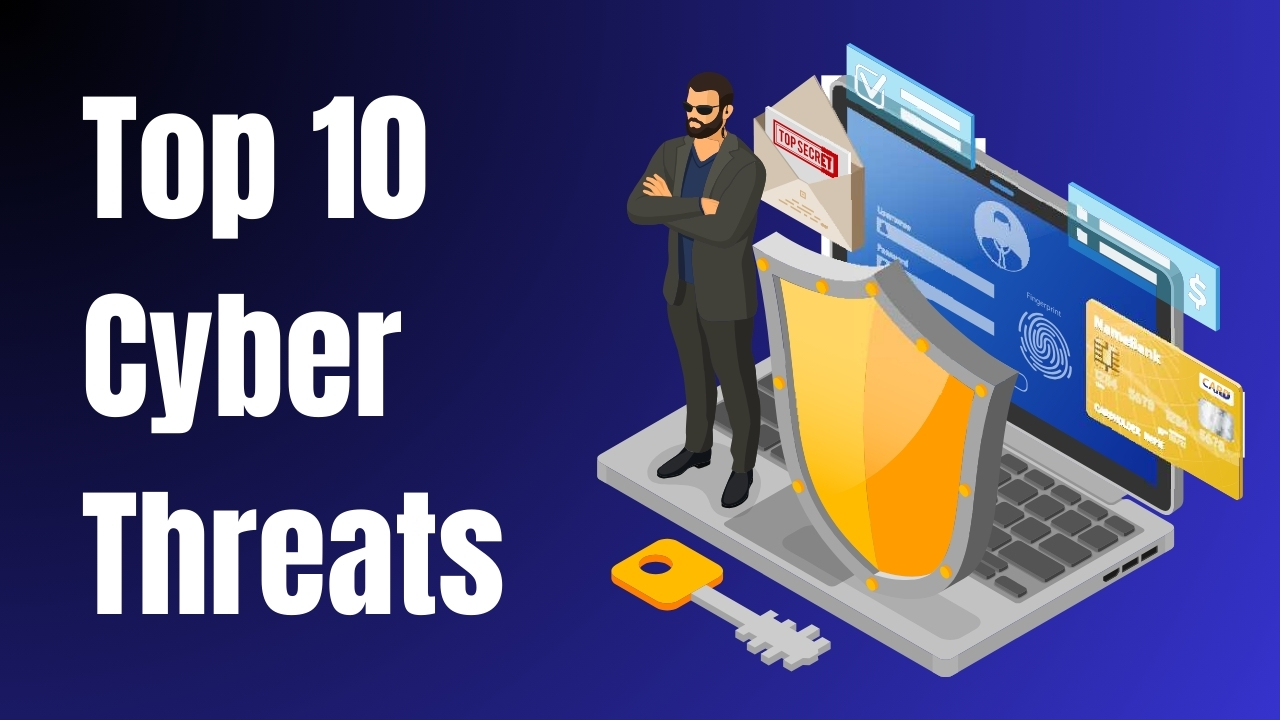The digital era has permeated every aspect of our existence. It is impossible to deny our reliance on technology, from connected houses to online banking. But there’s a cost to this convenience: vulnerability. Cybercriminals are always coming up with new strategies to take advantage of holes in our digital systems.
This blog delves deeply into the top 10 cyberthreats that are secretly looming large in the digital world. We’ll break down each threat, assess its possible effects, and look into ways to strengthen your defenses through mitigation.
The Ten Greatest Cyberthreats:
- Social Engineering: This strategy plays on victims’ emotions and psychological vulnerabilities to entice them to divulge personal information or click on harmful links. Social engineering strategies include phone calls pretending to be from reliable sources, phishing emails, and social media frauds.
- Effect : Financial loss, identity theft, data breaches, and even corporate operational interruption can result from social engineering.
- Mitigation : Incorporate email filtering and anti-phishing software, teach staff members on social engineering techniques, and promote a cyberaware culture within the company.
2. Ransomeware : The files of a victim are encrypted by this malicious software, making them unreadable. Subsequently, cybercriminals want a payment of ransom to obtain the decryption key. Attacks using ransomware have the power to destroy vital infrastructure, businesses, and even medical facilities.
- Effect : Significant financial losses, business interruptions, data loss, and reputational harm can all result from ransomware.
- Mitigation : To help defray the costs of a ransomware attack, regularly backup your data, apply security patches as soon as possible, and think about purchasing cyber insurance.
3. Malware: a general word for a variety of malicious software applications intended to steal information, interfere with operations, or enter systems without authorization. Malware includes worms, Trojan horses, spyware, and adware.
- Effect: Malware can cause identity theft, system interruptions, financial losses, and data breaches.
- Mitigation: Keep your software up to date, use antivirus and anti-malware software, exercise caution when clicking links or opening attachments in emails, and stay away from installing software from unreliable sources.
4. Cloud Vulnerabilities: Although cloud computing has many advantages, there are new security risks as well. Cloud platform misconfigurations, unsafe APIs, and data breaches can significantly affect businesses that depend on them.
- Effect: Vulnerabilities in the cloud may result in data leaks, unwanted access to private data, and interruption of cloud-based services.
- Mitigation: Select trustworthy cloud service providers with good security protocols, put in place strict access limits, and routinely check cloud infrastructure for security flaws.
5. Vulnerabilities with Mobile Devices: The widespread use of tablets and smartphones has given hackers a large attack surface. Significant security threats can arise from lost or stolen smartphones, malicious software, and unreliable mobile networks.
- Effect: Vulnerabilities in mobile devices can result in malware infections, identity theft, financial loss, and data breaches.
- Mitigation: Use strong passwords and two-factor authentication, encrypt critical data on your devices, download programs only from reliable sources, exercise caution when using public Wi-Fi.
6. Internet of Things (IoT) Security: The Internet of Things (IoT), an ever-expanding network of connected objects, poses particular security challenges. Many Internet of Things (IoT) devices have lax security measures and are open to hacking, which might have a cascading effect if one of them is compromised.
- Effect: IoT vulnerabilities have the potential to cause major infrastructure disruption, privacy invasion, and botnet attacks.
- Mitigation: Select Internet of Things (IoT) devices with robust security features, separate the IoT network from your main network, update firmware frequently, and alter default passwords.
7. Phishing: Sending emails or texts that seem to be from reputable organizations, including banks, credit card firms, or social networking platforms, is one way that cybercriminals use this strategy. The intention is to deceive the target into opening harmful links or entering personal data.
- Effect: Financial loss, identity theft, data breaches, and malware infections are all possible outcomes of phishing attempts.
- Mitigation: Avoid sending personal information to dubious websites, be cautious when responding to unwanted emails and texts, and make sure two-factor authentication is on for all of your accounts.
8. Supply Chain Attacks: Attacks by cybercriminals are increasingly aimed against unaffiliated suppliers and providers. They can obtain access to the network of the target organization by breaching a less secure system anywhere in the supply chain.
- Effect: Attacks on supply chains have the potential to cause malware outbreaks, data breaches, and operational disruptions for the targeted company as well as its suppliers.
- Mitigation: Carry out in-depth security evaluations of suppliers and vendors, impose stringent access restrictions, and establish ongoing supply chain surveillance to detect any unusual activity.
9. Insider Threats: An important security risk can come from irate workers, contractors, or even privileged users with authorized access. These people might compromise networks, steal data, or sell access to hackers.
- Effect: Data breaches, monetary losses, operational disruptions, and reputational harm can all result from insider threats.
- Mitigation: Establish a culture of security awareness inside the company, perform background checks on contractors and staff, monitor user activity for unusual activities, and implement strict access limits based on the least privilege principle.
10. Zero-Day Attacks: These are undiscovered weaknesses in hardware or software that hackers take advantage of before a fix is made available. Because there is currently no known defense against zero-day attacks, they are especially dangerous.
- Effect: Zero-day attacks have the ability to seriously harm government organizations, financial institutions, and vital infrastructure.
- Mitigation: Use security solutions that can identify and stop suspicious behavior, keep your operating systems and software up to date, and be ready to react swiftly in the event of a zero-day attack.
Conclusion
Cybersecurity is a never-ending conflict. Organizations can drastically lower their risk of hacking by being aware of the most common cyberthreats and putting strong security measures in place. In the digital realm, it’s important to keep in mind that prevention is always preferable than treatment. You can make everyone’s digital environment safer and more secure by being proactive in protecting your systems and data.


Leave a Reply